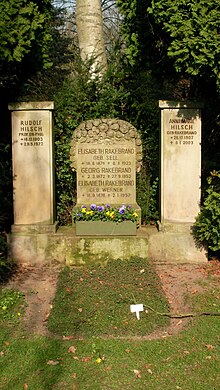Rudolf Hilsch
Rudolf Hilsch (born December 18, 1903 in Hamburg , † May 29, 1972 ) was a German physicist and university professor.
biography
Hilsch received his doctorate in Göttingen in 1927. From 1941 to 1953 Hilsch was a full professor of physics in Erlangen . In 1953 he was appointed to Göttingen, where he took over the management of the I. Physics Institute of the Georg-August University of Göttingen . He worked as a university lecturer in Göttingen until the 1960s. Since 1953 he was a full member of the Bavarian Academy of Sciences . In 1954 he was elected a full member of the Göttingen Academy of Sciences .
Act
In 1938 Robert Wichard Pohl and Hilsch built one of the first working semiconductor amplifiers together , but it only worked at very low frequencies. In 1939, Hilsch, who was still senior assistant to von Pohl at the time, was able to show in his investigation into the control of electron currents in crystals that solid-state electronics are possible. As early as 1933, Pohl had pointed out the possibility of replacing electron tubes with small crystal components. However, the technical realization took place much later with the invention of the transistor based on the semiconductors germanium and silicon .
Hilsch improved the construction of the vortex tube invented by the French physicist Georges J. Ranque in 1933 and published his highly acclaimed results in 1946. With the device, also known as the Ranque-Hilsch vortex tube, gas can be divided into a hot and a cold flow without moving parts .
Works (selection)
- The absorption spectrum of some alkali halide phosphors with Pb and Ti additives. Springer, Berlin 1927. In: Zeitschrift f. Physics, 44 (diss.).
- with RW Pohl: About the utilization of the latent image in photographic development. Weidmann, Berlin 1930
- with RW Pohl: About the latent photographic image. Weidmann, Berlin 1930
- The reflection of slow electrons in layers of ion crystals for the detection of optical energy levels. Weidmann, Berlin [1932]
- with RW Pohl: A new light absorption in alkali halide crystals. Weidmann, Berlin 1933
- with RW Pohl: On the photochemistry of alkali halide crystals. Weidmann, Berlin 1933
- The quantum yield in the formation of color centers in KBr crystals. Vandenhoeck & Ruprecht, Göttingen 1935
- with RW Pohl: On the photochemical elementary process in alkali halide crystals. Weidmann, Berlin 1934
- with RW Pohl: The quantum yield in the formation of color centers in KBr crystals. Weidmann, Berlin 1935
- with RW Pohl: About the nature of the U-centers in alkali halide crystals. Vandenhoeck & Ruprecht, Göttingen 1936
- with RW Pohl: On the photoelectric secondary current. Vandenhoeck & Ruprecht, Göttingen 1937
- Rudolf Hilsch: The expansion of gases in the centrifugal field as a cold process. In: Journal for Nature Research . 1, 1946, pp. 208-213 ( online ).
- with Fred Fischer: On the structure of the exciton bands of alkali halides. Vandenhoeck & Ruprecht, Göttingen 1959
- with G.Bergmann: Coherence effects in double layers of different superconductors. Vandenhoeck & Ruprecht, Göttingen 1965
- On the 80th birthday of Robert Wichard Pohl on August 10, 1964. Springer, Berlin / Heidelberg; ISSN 0028-1042
See also
Web links
- Literature by and about Rudolf Hilsch in the catalog of the German National Library
- University collections (HZK): Rudolf Hilsch (work)
Individual evidence
- ^ Rudolf Hilsch obituary at the Bavarian Academy of Sciences by Rudolf Fleischmann (PDF file).
- ↑ Holger Krahnke: The members of the Academy of Sciences in Göttingen 1751-2001 (= Treatises of the Academy of Sciences in Göttingen, Philological-Historical Class. Volume 3, Vol. 246 = Treatises of the Academy of Sciences in Göttingen, Mathematical-Physical Class. Episode 3, vol. 50). Vandenhoeck & Ruprecht, Göttingen 2001, ISBN 3-525-82516-1 , p. 114.
| personal data | |
|---|---|
| SURNAME | Hilsch, Rudolf |
| BRIEF DESCRIPTION | German physicist and university professor |
| DATE OF BIRTH | December 18, 1903 |
| PLACE OF BIRTH | Hamburg |
| DATE OF DEATH | May 29, 1972 |

